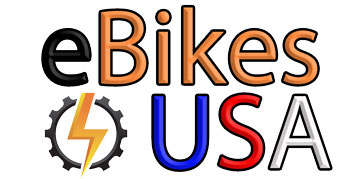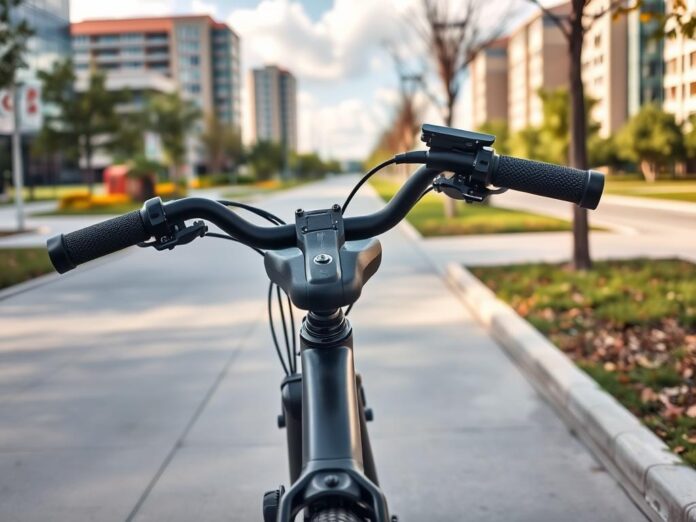The popularity of electric bicycles (e-bikes) is rising fast. This has made it important to make these bikes accessible to everyone. The Americans with Disabilities Act (ADA) says that all federal programs must be open to people with disabilities. E-bikes are seen as “other power-driven mobility devices” (OPDMD) under the ADA.
Many people with disabilities want to use e-bikes on trails not meant for cars. This shows a big need for more access on trails that don’t allow motor vehicles.
People with disabilities asking to use e-bikes on these trails are asking for “reasonable modification.” This is based on Section 504 of the Rehabilitation Act of 1973. This law makes sure that all federal programs are open and easy for people with disabilities to use. It’s all about making sure everyone can enjoy public lands.
Key Takeaways
- The Americans with Disabilities Act (ADA) requires federal programs and activities to be accessible to persons with disabilities.
- E-bikes are considered “other power-driven mobility devices” (OPDMD) under the ADA.
- Requests from individuals with disabilities to use e-bikes on non-motorized trails are considered “reasonable modification” requests under Section 504 of the Rehabilitation Act of 1973.
- Federal agencies must grant reasonable modification requests unless it constitutes a fundamental alteration or undue burden.
- BLM field offices have received numerous requests from the public to use e-bikes on non-motorized trails, indicating a growing demand for accessibility.
Understanding the ADA and Its Implications for e-Bikes
The Americans with Disabilities Act (ADA) ensures equal access for people with disabilities. It has big implications for e-bikes as mobility tools.
Definition of the ADA
The ADA is a key civil rights law. It bans discrimination against people with disabilities in public life. This includes jobs, transport, and access to places.
Importance of Compliance
Following the ADA is crucial for businesses and public places. Not meeting ADA standards can lead to legal trouble and fines. Knowing the ADA helps make e-bikes more accessible for everyone.
E-Bikes as Mobility Devices
E-bikes are seen as “other power-driven mobility devices” (OPDMD) under the ADA. This means people with disabilities can use them in public. Places must allow the use of assistive e-bike technology unless it’s a safety risk.
“The ADA aims to ensure that persons with disabilities have equal access to public facilities and services.”
Types of e-Bike Modifications for Accessibility
Inclusive e-bike design is key for making e-bikes accessible to everyone. This includes wheelchair e-bike conversions and custom upgrades for mobility. These changes make e-bikes better for people with different mobility needs.
Handlebar and Seat Adjustments
Adjusting the handlebars and seat is a big part of e-bike customization. It helps riders find a comfy and safe riding spot. Adjustable handlebars can be changed to fit better, and seats can be adjusted for support and comfort.
Motor and Battery Upgrades
Upgrading the motor and battery can help a lot for those with less strength or endurance. More power and longer battery life mean easier rides up hills and longer distances. These changes are great for wheelchair e-bike conversions and other upgrades.
Accessory Additions
Adding accessories can make e-bikes more accessible and stable. Things like hand controls, foot straps, and safety harnesses can help. They offer extra support and security, making it easier for riders with disabilities to move around.
By making these changes, e-bike makers and aftermarket providers can make e-bikes more inclusive. This helps people with mobility, circulatory, respiratory, or neurological disabilities. It improves their quality of life and independence.
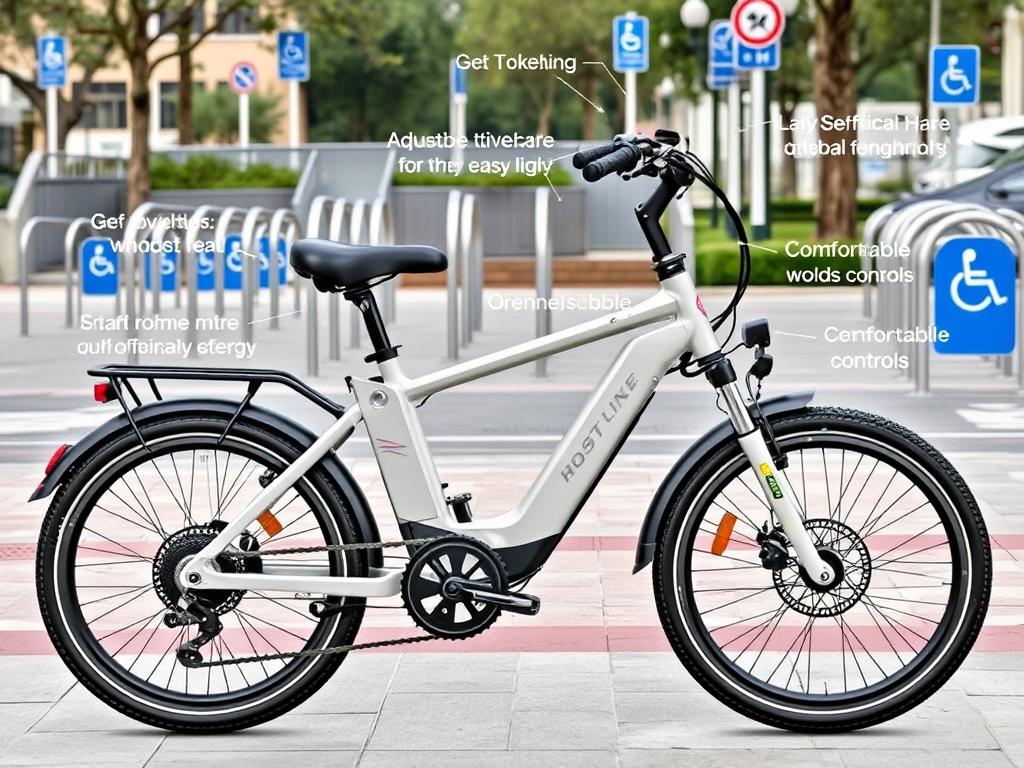
Your Rights as an e-Bike User Under the ADA
As an e-bike user, you have important rights under the Americans with Disabilities Act (ADA). The ADA lets you choose the mobility device that fits your needs, like e-bikes. Businesses and government agencies must let you use your e-bike unless it’s a safety risk.
Protection Against Discrimination
The ADA stops discrimination against people with disabilities, including e-bike users. Businesses can’t deny you access or services just because you use an e-bike. They must change their rules to meet your needs.
Reasonable Accommodations
If a business says no to your e-bike, they must offer another way to get around. This could be a loaner device or another transport option. They need to work with you to find the best solution.
Filing a Complaint
If you think your ADA rights were broken, you can file a complaint. Contact the U.S. Department of Justice or your state’s disability rights agency. They will look into it and take action if needed.
Remember, the ADA protects your rights as an e-bike. It ensures you have access to the mobility device you need. By knowing your rights and speaking up, you can get the accommodations you deserve.
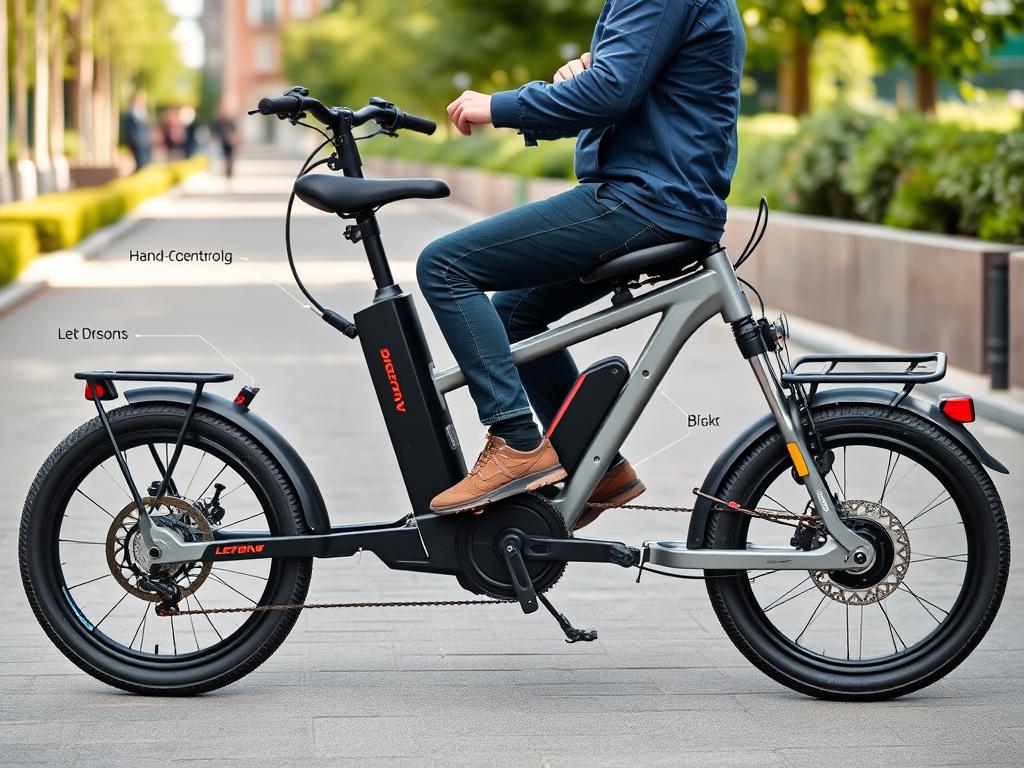
Determining What Constitutes a Disability
Understanding what a disability is is key for e-bike users. The Americans with Disabilities Act (ADA) defines it clearly. A disability is a physical or mental issue that makes it hard to do major life activities. This includes problems with walking, standing, or climbing stairs.
Definition of a Disability
The ADA lists many mobility issues. These include needing manual or power wheelchairs, scooters, and e-bikes. These tools help people with disabilities move around easily.
How the ADA Defines Mobility Impairments
- Difficulties with walking, standing, or climbing stairs
- Conditions that substantially limit major life activities
- Recognized use of manual or power wheelchairs, scooters, and other power-driven mobility devices
Knowing the ADA’s definition helps e-bike users fight for their rights. They can ask for disability-friendly e-bike enhancements, accessible e-bike modifications, and assistive e-bike technology they need to succeed.
The Process for Requesting e-Bike Modifications
Getting your e-bike modified can seem hard. But, by knowing the steps and working with experts, you can make your e-bike fit your needs. Let’s look at what you need to do.
Assessing Your Needs
Start by thinking about what you need to ride comfortably. Look at your movement, balance, and any physical issues. This helps you figure out what changes will make riding better and safer for you.
Working with Professionals
It’s important to work with healthcare or mobility experts. They can suggest the best changes for you. They also help with the paperwork and make sure the changes follow the ADA rules.
Documenting Modifications
Keep good records of your needs, the advice from experts, and the changes made. This proof is important to show why the changes are needed and to follow the ADA rules.
By following these steps, you can make your e-bike fit your needs. This way, you can ride with freedom and confidence. Always put your safety and accessibility first when making changes to your e-bike.
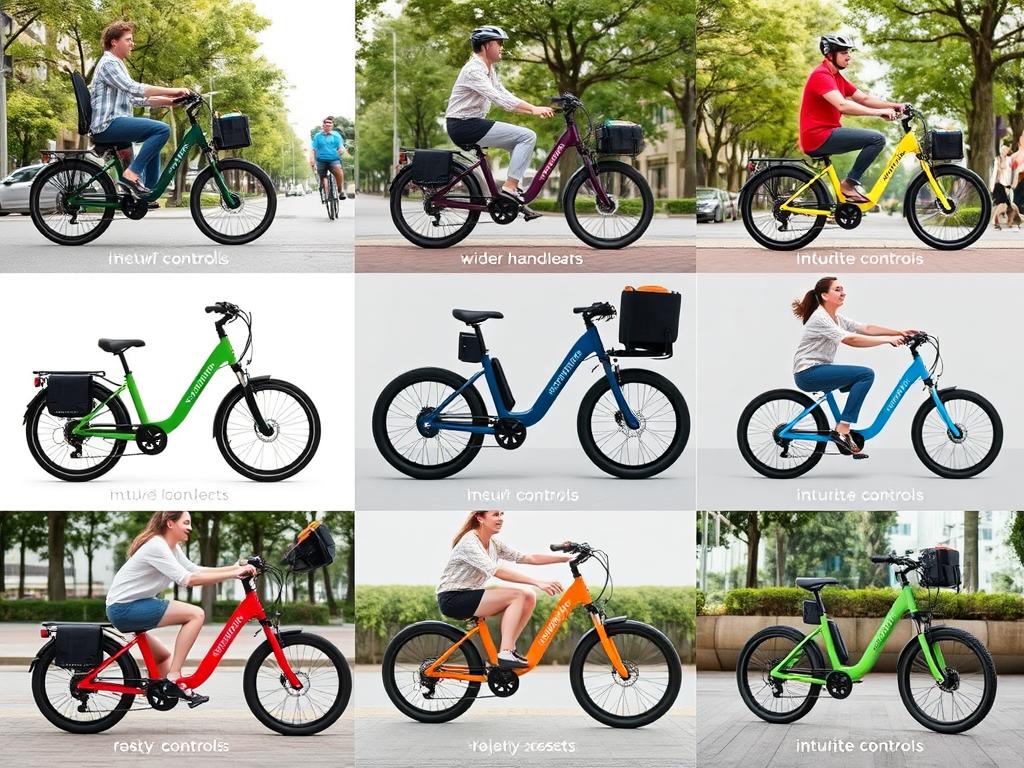
“Inclusive e-bike design is not just about making our rides more accessible – it’s about empowering individuals with mobility challenges to experience the joy and freedom of cycling.”
Common e-Bike Modifications for Enhanced Accessibility
Electric bikes (e-bikes) are becoming more popular. It’s important to know about the modifications that make them more accessible for people with disabilities. These changes help riders enjoy the benefits of e-bikes fully.
Enhanced Control Features
Improving control features is a key focus for e-bike modifications. Changes to brakes and throttle, like lever extensions, help riders with limited dexterity. These updates make riding safer and more comfortable.
Customizable Speed Settings
Another important feature is customizable speed settings. Riders can adjust the electric assistance to fit their needs. This allows everyone to find the right balance between electric help and their own effort.
Additions for Stability
Adding features for stability is also crucial. Training wheels or outriggers provide extra support. They help riders with balance issues feel more confident and safe.
These modifications make e-bikes more accessible for people with disabilities. They show the industry’s dedication to making mobility solutions inclusive. This way, everyone can enjoy the freedom and benefits of e-bikes.
Legal Considerations for e-Bike Modifications
Modifying your e-bike requires careful thought about the law. [https://ebikesus.com/e-bike-traffic-laws/] Making it ADA compliant, disability-friendly, and accessible must follow local rules.
Ensuring Compliance with Local Laws
Rules for e-bikes vary by state and city. It’s key to check your area’s laws for accessible e-bike modifications. Some places have specific rules for different types of e-bikes.
Liability Concerns
Liability is another big issue. If your ADA compliant e-bike adaptations or disability-friendly e-bike enhancements aren’t done right, you could face legal trouble. Talk to lawyers to make sure your changes are safe and don’t put you at risk.
Permissible Modifications
Choosing the right accessible e-bike modifications is crucial. You want to meet your needs without compromising safety. Work with experts to find the best modifications for you.
| Modification | Compliance Considerations | Potential Liability Concerns |
|---|---|---|
| Handlebar and Seat Adjustments | Ensure adjustments do not exceed local speed limits or compromise the e-bike’s stability and control. | Improperly adjusted handlebars or seat could lead to loss of control and accidents. |
| Motor and Battery Upgrades | Verify that motor power and battery capacity fall within local classification guidelines for e-bikes. | Exceeding power or speed limits could result in the e-bike being classified as a motor vehicle, leading to registration and licensing requirements. |
| Accessory Additions | Ensure any added accessories, such as lights or mirrors, do not interfere with the e-bike’s safe operation or visibility. | Improperly installed or malfunctioning accessories could cause accidents or damage. |
By staying informed and working with experts, you can make your e-bike more accessible and disability-friendly. This ensures you follow local laws and reduces legal risks.
Resources for e-Bike Users Seeking Modifications
The need for assistive e-bike technology and inclusive design is growing. Many resources are available to help users find the right modifications. You can get help from government agencies, disability rights groups, or online forums. These options can ensure your e-bike fits your needs perfectly.
Government Agencies and Organizations
The U.S. Department of Justice and the Bureau of Land Management (BLM) offer important information. They talk about the Americans with Disabilities Act (ADA) and its impact on e-bikes. The BLM, for instance, updated its rules to include e-bikes on certain roads and trails. This makes it easier for more people to use e-bikes.
Online Communities and Support Groups
Online forums and disability advocacy groups also provide support. They share knowledge on how to modify e-bikes and connect with local resources. These communities help ensure your e-bike meets legal standards. Joining them can greatly improve your e-bike experience.
As an e-bike user, you have the right to ask for modifications. There are many resources to help you make informed choices. By using these resources, you can find the best e-bike design for your needs.
The Role of Manufacturers in ADA Compliance
E-bike manufacturers are key in making sure products meet the Americans with Disabilities Act (ADA). They design bikes that can be modified for easier use. This helps make technology more accessible to everyone.
Manufacturer Liability
Manufacturers face legal issues when it comes to making e-bikes accessible. They need to give clear instructions for customizing bikes. Working with disability groups helps them avoid legal problems and meet ADA standards.
Standards for Accessibility
For e-Bike Modifications Under ADA, makers must team up with experts and regulators. They focus on features like adjustable handles and customizable speeds. This way, they make e-bikes for more people with different needs.
The success of making e-bikes more accessible depends on everyone working together. This includes manufacturers, lawmakers, and the disability community. Together, we can make sure e-bike technology is available to all.
“Manufacturers play a pivotal role in shaping the future of accessible e-bike technology. Their commitment to inclusive design and compliance with the ADA will determine the level of mobility and independence enjoyed by individuals with disabilities.
Staying Informed About Your Rights and Options
As an electric bike (e-bike) user, knowing your rights is key. It’s important to keep up with new rules and changes. This way, you can ride safely and comfortably, following the Americans with Disabilities Act (ADA).
By staying informed, you can make sure your e-bike rides are the best. Visit this website for more information.
Best Practices for Advocacy
Work to make e-bikes more accessible for people with disabilities. Join local groups, go to meetings, and talk to lawmakers and bike makers. Your efforts can help make e-bikes better for everyone.
Recent Developments in ADA Regulations
Keep up with ADA rule changes, like the Department of Justice’s new e-bike rules. Also, know about the Bureau of Land Management’s (BLM) plans to let more people with disabilities enjoy public lands. These changes can open up new outdoor adventures for you.
Continuous Learning and Adaptation
Always be ready to learn and adapt with your e-bike. New tech and ways to use your bike come out all the time. By keeping up and trying new things, your e-bike will stay a great way to get around.
